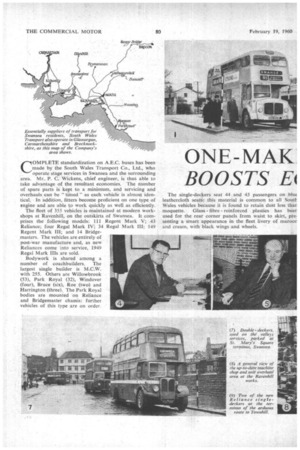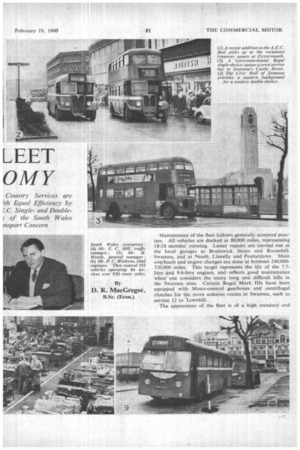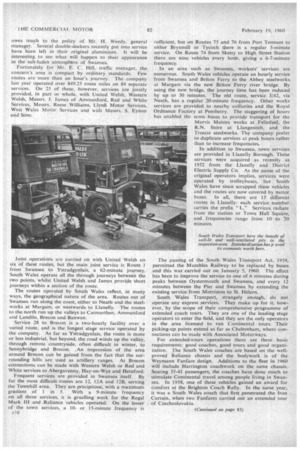ONE-MAK LEET BOOSTS El 0111Y
Page 52

Page 53

Page 54

Page 57

If you've noticed an error in this article please click here to report it so we can fix it.
COMPLETE standardization on A.E.C. buses has been made by the South Wales Transport Co., Ltd., who operate stage services in Swanseaand the surrounding area. Mr. P. C. Wickens, chief engineer, is thus able to take advantage of the resultant economies. The number of spare parts is kept to a minimum, and servicing and Overhauls, can be— tirned " as each vehicle is almost identical. In addition, fitters become proficient on one type of engine and are able to work quickly as well as efficiently.
The fleet of 355 vehicles is maintained at modern workshops at Ravenhill, on the outskirts of Swansea. It comprises the following Models: 111 Regent Mark V; 43 Reliance; four Regal Mark IV; 34 Regal Mark III; 149 Regent Mark III; and 14 Bridgemasters. The vehicles are entirely of .post-war manufacture and, as new Reliances come into service, 1949 Regal Mark Ills are sold.
Bodywork is shared among a number of coachbuilders. The largest single builder is M.C.W. with 255. Others are Willowbrook (53), Park Royal (32), Windover (four), Bruce (six), Roe (two) and Harrington (three).. The Park Royal bodies are mounted on Reliance and Bridgemaster chassis: further vehicles of this type are on order. The single-deckers seat 44 and 45 passengers on bluf leathercloth seats: this material is common to all Scant' Wales vehicles because it is found to retain dust less than moquette. Glass fibre reinforced plastics has beer used for the _rear corner panels from waist to skirt, presenting a smart appearance in the fleet livery of maroon and cream, with black wings and wheels.
Maintenance of the fleet follows generally accepted practice. All vehicles are docked at 80,000 miles, representing 18-24 months' running. Lesser repairs are carried out at the local garages at Brunswick Street and Ravenhill. Swansea. and at Neath, Llanelly and Pontardawe. Main overhauls and engine changes are done at between 240,000320,000. miles. This target represents the life of the 7.7litre and 9.6-litre engines, and reflects good maintenance when one considers the many long and difficult hills in the Swansea area. Certain Regal Mark Ills have been equipped with Mono-control gearboxes and centrifugal clutches for the more arduous routes in Swansea, such as service 12 to Townhill..
The appearance of the fleet is of a high standard and owes much to the policy of Mr. H. Weedy. general manager. Several double-deckers recently put into service have been left in their original aluminium. It will be interesting to see what will happen. to their appearance in the salt-laden atmosphere of Swansea.
Fortunately for Mr. E. C. Hill, traffic manager, the concern's area is compact by ordinary standards. Few routes are more than an hour's journey. The company last year operated over 849.25 route miles on 84 separate services. On 25 of these, however, services are jointly provided, in part or whole, with. United Welsh, Western Welsh, Messrs. J. James of AmmanfOrd, Red and White Services, Messrs. Reese Williams, Llynfi Motor Services, West Wales Motor Services and with Messrs. S. Eynon and Sons.
Joint operations are carried on with United Welsh on six of these routes, but the main joint service is Route I from Swansea to Ystradgynlais, a 62-minute journey. South Wales operate all the through journeys between the two points, whilst United Welsh and James provide short journeys within a section of the route.
The routes operated by South Wales reflect, in many ways, the geographical nature of the area. Routes out of Swansea run along the coast, either to Neath and the steelworks at Margam, or westwards to Llanelly. The routes to the north run up the valleys to Carmarthen, Ammanford and Landilo, Brecon and Banwen.
Service 28 to Brecon is a two-hourly facility over a varied route, and is the longest stage service operated by the company. As far as Ystradgynlais, the route is more or less industrial, but beyond, the road winds up the valley, through remote countryside, often difficult in winter, to Sennybridge and Brecon. , An impression of the area around Brecon can be gained from the fact that the surrounding hills are used as artillery ranges. At Brecon connections can be made with Western Welsh or Red and White services to Abergavenny, Hay-on-Wye and Hereford.
Frequent services are provided in Swansea itself. By far the most difficult routes are 12, 12A and I2B, serving the Townhill area. They are precipitous, with a maximum gradient of 1 in 5. With a 9-minute frequency on all three services, it is gruelling work for the Regal Mark Ill and Reliance vehicles operated. On the lesser of the town services, a 10or 15-minute frequency is c18 sufficient, but on Routes 75 and 76 from Port Tennant to either Brynmill or Tycoch there is a regular 5-minute service. On Route 74 from •Sketty to High Street Station there are nine vehicles every hottr, giving a 6-7-minute frequency.
In an area such as Swansea, workers' services are numerous. South Wales vehicles operate an hourly service from Swansea and Briton Ferry to the Abbey steelworks at Margam via the new Briton Ferry river bridge. By using the new bridge, the journey time has been reduced by up to 30 minutes. The old route, service 3/42, via Neath, has a regular 20-minute frequency. Other works services are provided to nearby collieries and the Royal Ordnance Factory at Pemberry. The staggering of hours has enabled the same buses to provide transport for the Morris Motors works at Felinfoel, the R.N. Store at Llangenech, and the Trostre steelworks. The company prefer to duplicate services at peak hours rather than to increase frequencies.
In addition to Swansea, town services are provided in Llanelly Borough. These services were acquired as recently as 1952 from the Llanelly and District Electric Supply Co. As the name of the original operators implies, services were operated by trolleybuses, but South Wales have since scrapped these vehicles and the routes are now covered by motor buses. In all, there are 15 different routes in Llanelly: each service number " carries the prefix "L." Services radiate from the station or Town Hall Square, and frequencies range from 10 to '20 minutes.
The passing of the South Wales Transport Act, 1959, permitted the Mumbles Railway to be replaced by buses and this was carried out on January 5, 1960. The effect has been to improve the service to one of 6 minutes during peaks between Oystermouth and Swansea, and every 12 minutes between the Pier and Swansea by extending the existing service from Morriston to St. Helens.
South Wales Transport, strangely enough, do not operate any express services. They make up for it however, by the scope of their comprehensive programme of extended coach tours. They are one of the leading stage operators to enter the field, and they are the only operators in the area licensed to run Continental tours. Their picking-up points extend as far as Cheltenham, where connections can be made with Associated Motorways.
For extended-tours operations there are three basic requirements: good coaches, good tours and good organization. The South Wales coaches are based on the wellproved Reliance chassis and the bodywork is of the Weymann Fanfare design. Additions to the fleet in 1960 will include Harrington coachwork on the same chassis. Seating 37-41 passengers, the coaches have done much to stimulate Continental travel among people living in Swansea. In 1958, one of these vehicles gained an award for comfort at the Brighton Coach Rally. In the same year, it was a South Wales coach that first penetrated the Iron Curtain, when two Fanfares carried out an extended tour of Czechoslovakia. To cater for these tours, a special department was formed at the head office in Russell Street so that all inquiries and bookings could be dealt with efficiently. Tours of varying duration are run to most Western European countries, and• for those wanting extended tours in Great Britain there is a selection which includes Scotland, Wales, the Channel Islands, South Coast, London, and Blackpool. The tours department also deal with private hire and act as agents for Associated Motorways, British Railways (Continental Rail Travel), Butlin's holiday camps, Silver City Airways, Europabus and the Scottish Omnibus group. With a fleet of 355 vehicles, South Wales can be considered of medium size within the B.E.T. group, and with a compact area of operation, one is apt to miss the high regard which the Welsh people have for the company. Since 1936, with the granting of the Swansea and District Transport Act, close co-operation has been maintained with the local council. This authority has a share of the profits and there is a joint consultative transport committee.








































































































